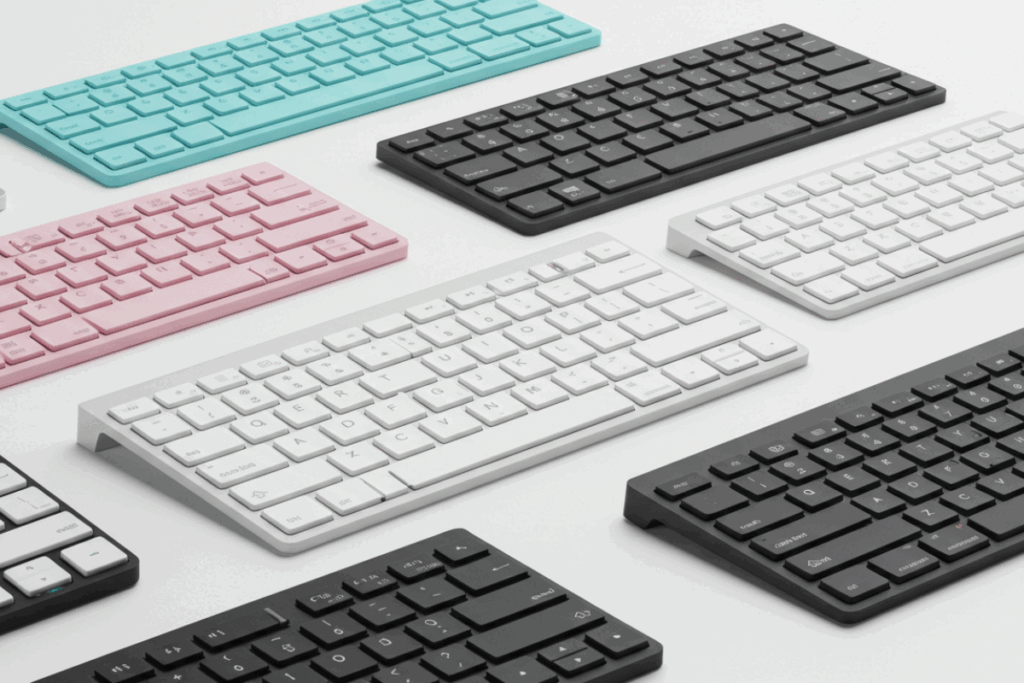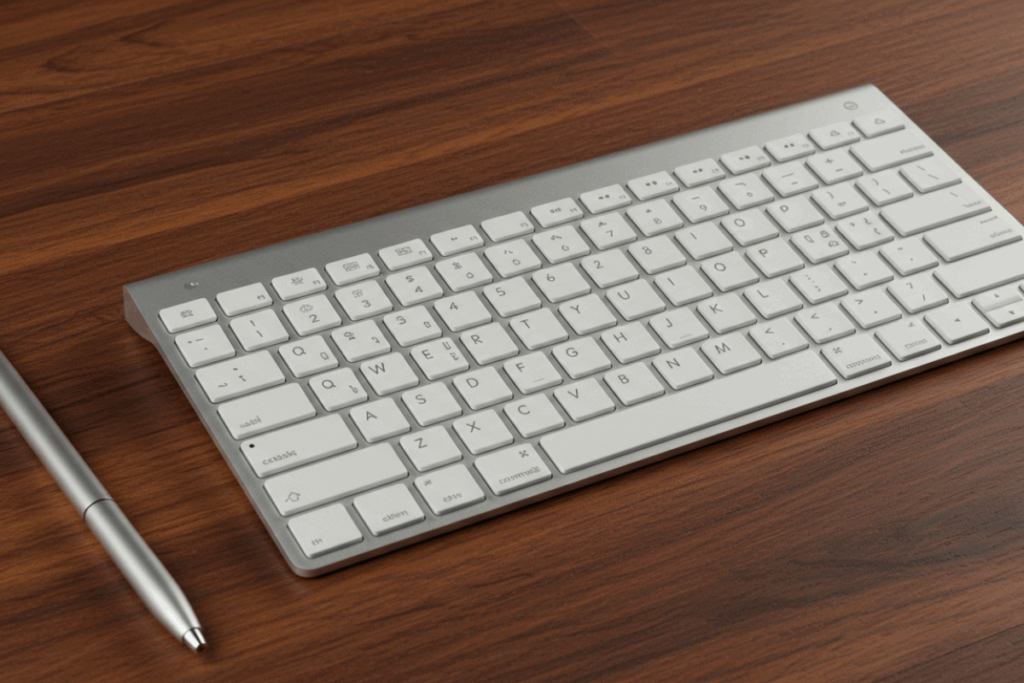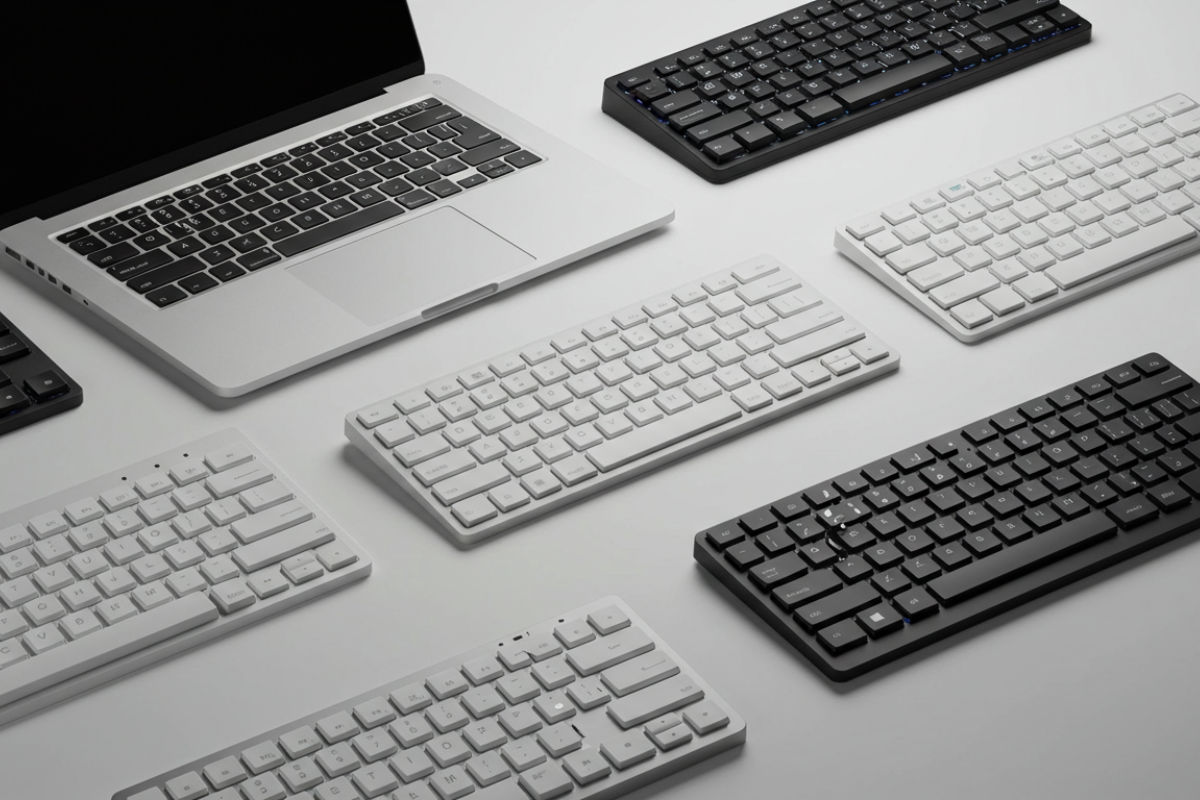Keyboards for Mac users are what I test and recommend at Keyboards Technology. I focus on why I value macOS shortcuts, Touch ID, and reliable media keys. I compare Magic Keyboard alternatives, layouts (full‑size, TKL, compact), and choices like ergonomic, low‑profile vs high‑profile.
I explain my switch picks—scissor, low‑profile, or hot‑swappable mechanical—and how I test Bluetooth, USB‑C, battery life, and multi‑device pairing. I also cover remapping, macros, firmware tools, and the best picks for developers, creatives, writers, and gamers, with budget and care tips.
Key Takeaway
- I prefer keyboards that match macOS key mapping and include Mac legends.
- Slim, Apple‑style looks work well on my desk; low‑profile boards are great for travel.
- Quiet, comfortable switches improve long typing sessions.
- Built‑in macOS shortcuts, Touch ID, and consistent media keys save time.
- I trust brands with good support and frequent firmware updates.
Why I prioritize Mac features when choosing keyboards for Mac users
I choose keyboards that feel like an extension of my Mac—small things like macOS shortcuts, Touch ID, and predictable media keys remove friction. For anyone shopping for keyboards for Mac users, Mac‑first mapping and reliable firmware are non‑negotiable.
How I use macOS shortcuts, Touch ID and media keys every day
- macOS shortcuts (Command‑Tab, Command‑Shift‑4) speed app switching and screenshots.
- Touch ID on a keyboard streamlines login and approvals without typing passwords.
- Media keys let me control podcasts and volume without breaking workflow.
Daily routine: write emails, edit audio, run quick searches—good Mac controls keep me focused.
Apple Magic Keyboard alternatives I trust for macOS compatibility
I use the Apple Magic Keyboard sometimes, but I often prefer alternatives that add comfort while keeping a Mac‑friendly layout. Key things I look for:
- Correct macOS key mapping (Command, Option in the right spots)
- Reliable Bluetooth and wired options (USB‑C)
- Built‑in Touch ID or seamless pass‑through
- Solid media keys that behave like macOS icons
What sold me on alternatives is consistent behavior—no surprises when switching Macs.
Touch ID, function row and media icon differences
| Feature | Apple Magic Keyboard | Mac‑focused third‑party | Other third‑party |
|---|---|---|---|
| Touch ID | Available on some models | Available or pass‑through | Rare / inconsistent |
| Function row | F1–F12 with macOS icons | macOS icons; sometimes programmable | Mixed, may need remapping |
| Media keys | Standard macOS icons | Standard extras | Behavior varies |
| Key mapping | Native macOS layout | Native or switchable | Often Windows‑first |
| Connection | Bluetooth / Lightning | Bluetooth / USB‑C / wired | Varies; may lag |
If brightness keys show but don’t work without drivers, that’s a deal‑breaker for me.
How I compare keyboard types: full‑size, TKL and compact keyboards for Mac users
Layout choice depends on tasks:
- Full‑size: best for spreadsheets and number‑heavy work (numeric pad).
- TKL (tenkeyless): ideal for coding and balanced desk ergonomics.
- Compact: best for travel and small setups; pairs neatly with a MacBook.
I always check for Mac key legends and how well the board maps to macOS. For anyone choosing among keyboards for Mac users, pick the layout that fits your daily workflow.
| Layout | Best for | Pros | Cons |
|---|---|---|---|
| Full‑size | Numeric work | Number pad; familiar | Larger footprint |
| TKL | Typing space | More desk room | No number pad |
| Compact | Travel | Portable | Fewer keys, learning curve |
Why I pick ergonomic or split layouts for comfort
A split or ergonomic board can reduce wrist strain and improve posture during long sessions. I prefer models with slight tenting and adjustable angles—small mechanical changes can make long writing days painless.
Benefits:
- Reduced wrist strain
- Better posture
- Easier long sessions
Low‑profile versus high‑profile: portability tradeoffs
| Feature | Low‑profile | High‑profile |
|---|---|---|
| Height | Thin | Tall |
| Travel | Short | Long |
| Portability | High | Low |
| Typing feel | Fast, crisp | Deep, tactile |
Low‑profile for commuting; high‑profile for satisfying desk typing.
How I choose switches: scissor, low‑profile mechanical and hot‑swappable options
I match switches to the task and to macOS workflows. For keyboards for Mac users, the right switch minimizes fatigue and makes shortcuts feel natural.
Scissor vs low‑profile mechanical
| Feature | Scissor‑switch | Low‑profile mechanical |
|---|---|---|
| Travel | Short | Short–medium |
| Sound | Quiet | Moderately quiet |
| Feedback | Soft | More tactile |
| Best for | Long typing, travel | Typists wanting slim tactile feel |
When to prefer hot‑swappable mechanical
Hot‑swap boards let me test switches quickly—great for customizing feel or trying tactile vs linear vs clicky without soldering.
My quick testing method:
- Start with a low‑force linear for speed.
- Try a light tactile for editing and shortcuts.
- Test clicky for brief satisfaction and to judge noise.
Switch actuation, travel and tactile choices that suit macOS workflows
| Task | Actuation force (g) | Travel (mm) | Recommended feel |
|---|---|---|---|
| Fast typing / chats | 35–45g | 1.5–3.0mm | Light linear |
| Long writing | 45–55g | 1.5–3.0mm | Light tactile |
| Code / shortcuts | 45–60g | 1.5–3.5mm | Clear tactile |
| Loud satisfaction | 50–60g | 2.0–4.0mm | Clicky tactile |
Short travel speeds combos like CmdC; lighter force reduces fatigue; tactile bumps confirm shortcuts without looking.

How I test connectivity: Bluetooth keyboards for Mac and wireless Mac keyboards
I check reliability, latency, and real‑world behavior—pairing, range, and multi‑device switching.
Testing steps:
- Start with full battery and latest firmware.
- Test at 0.5 m, 1.5 m, and 5 m.
- Run a typing test to feel lag.
- Do a 30‑minute video call to monitor dropouts.
| Test point | What I watch for | Why it matters |
|---|---|---|
| Pairing time | Seconds to connect | Quick setup |
| Range | No drops at 1.5 m | Stable desk use |
| Latency | Key vs screen | Natural feel |
| Multi‑device switch | Smooth switching | I switch Mac ↔ iPad often |
| Interference | Behavior near Wi‑Fi | Some setups need a dongle |
How I set up Bluetooth multi‑device pairing (Mac, iPad, iPhone)
Steps:
- Clear old pairings on keyboard and devices.
- Put keyboard in pairing mode and add to each device.
- Assign slots (if supported) to avoid accidental switches.
- Test common shortcuts on each device.
Practical tips:
- Toggle device Bluetooth if pairing stalls.
- Use separate slots for Mac and iPad.
- Keep firmware current.
| Step | iPhone | iPad | Mac |
|---|---|---|---|
| Prepare | Turn Bluetooth on | Turn Bluetooth on | Turn Bluetooth on |
| Pair | Find keyboard in list | Find keyboard in list | Find keyboard in list |
| Slot use | Slot 1 | Slot 2 | Slot 3 |
| Quick test | Type note | Open Pages | Open Notes |
When I prefer USB‑C wired or a wireless dongle
- Wired (USB‑C) for long calls, gaming, or deadline sprints—zero lag and charges while connected.
- A dedicated dongle for crowded wireless rooms to avoid Bluetooth interference.
| Connection | Best for | Stability | Notes |
|---|---|---|---|
| Bluetooth | Everyday laptop use | Good | Cable‑free |
| USB‑C wired | Long calls, gaming | Excellent | Charges while typing |
| Wireless dongle | Crowded wireless areas | Very good | Bypasses Bluetooth congestion |
Battery life, charging speed and real‑world endurance for portable Mac keyboards
I charge fully, then use until a battery warning appears—testing with backlight on/off and heavy vs light use.
What I monitor:
- Backlight level (biggest drain)
- Idle sleep behavior
- Charging speed from empty to full
- Real‑world hours under normal use
| Factor | Effect on battery | My note |
|---|---|---|
| Backlight high | Big drain | Turn off for long trips |
| Backlight off | Much less drain | Good for travel |
| Heavy typing | Moderate drain | Still many hours |
| Idle sleep | Saves battery | Needs quick wake |
I carry the cable on trips; a keyboard that lasts a full workday earns reliability points.
How I customize keys: remapping and macros on Mac‑compatible programmable keyboards
Custom mapping and macros are huge time savers for keyboards for Mac users. I use hardware mapping and macOS tools to reduce finger travel and automate repeated tasks.
How I remap Command, Option and Control
Common swaps I use:
- Swap Caps Lock to Control for coding.
- Move Option left of Command to speed accents.
- Keep one Command as‑is for app shortcuts.
| Physical key | Mapped to | Why |
|---|---|---|
| Caps Lock | Control | Easier modifier for shortcuts |
| Left Control | Option | Frees pinky |
| Left Option | Command | Faster app shortcuts (left hand) |
| Right Option | Option | Keeps special chars on right thumb |
Steps:
- System Settings > Keyboard > Modifier Keys for basic swaps.
- Use the vendor app for per‑profile on‑board remaps.
- Test changes for a day and tweak.
How I use macros and profiles
I treat macros like small scripts—open apps, paste templates, run sequences. Profiles separate coding, writing, and design setups.
| Profile | Main changes | When I use it |
|---|---|---|
| Coding | Caps→Control, build/test macros | Dev sessions |
| Writing | Left Option→Command, punctuation macros | Drafting |
| Design | Media keys & Photoshop shortcuts | Editing visuals |
I set app‑based auto‑switches in the configurator and keep a physical profile key for manual cycling.
Firmware updates, macOS tools and software I rely on
I back up profiles before updates and update while plugged in.
| Tool | Purpose | Notes |
|---|---|---|
| Keyboards Technology Configurator | On‑board mapping, profiles, firmware | Go‑to for hardware changes |
| Karabiner‑Elements | Deep macOS remapping | Use for rules hardware can’t set |
| BetterTouchTool | Custom shortcuts, gestures | App window snapping and workflows |
| macOS Keyboard | Basic modifier swaps | First place to tweak |
Firmware routine: backup → read release notes → update while plugged → test top macros.
How I recommend keyboards for different users and budgets (including the best keyboards for Mac users)
I test boards weekly. My recommendations focus on comfort, reliability, and value—especially for keyboards for Mac users looking for Apple‑like behavior.
My picks for developers, creatives, writers and Mac gamers
| User | Pick (Keyboards Technology) | Why | Switch | Price |
|---|---|---|---|---|
| Developers | KT Dev Pro | Solid layout, Mac keycaps | Tactile / Brown | $120–$160 |
| Creatives | KT Studio 75 | Compact, quiet, color options | Silent tactile | $140–$200 |
| Writers | KT Quiet Type | Soft travel, low noise, long battery | Low‑profile linear | $90–$130 |
| Mac Gamers | KT Click X | Fast actuation, N‑key rollover | Clicky / Speed | $130–$220 |
I always verify macOS shortcut compatibility and prefer boards that ship with Mac keycaps.
Balancing price, build quality, Apple Magic Keyboard alternatives and warranty
| Factor | What I check | Quick tip |
|---|---|---|
| Price | Materials & switches | Spend more for a metal plate |
| Build quality | Case, stabilizers, hot‑swap | A good stabilizer saves hours |
| Magic Keyboard alternatives | Mac layout, latency, low profile | Look for Mac keycaps or Mac mode |
| Warranty | Length & coverage | At least 1 year from trusted brand |
A cheap board with bad stabilizers is a false economy; warranty and parts support matter.
Maintenance tips, replacement parts and long‑term care for Mac keyboards
- Clean keycaps weekly; deep clean and remove caps every few months.
- Lubricate stabilizers with light synthetic lube to stop rattle.
- Swap switches on hot‑swap boards to extend life.
- Keep firmware updated.
- Use a cover or sleeve when transporting.
| Part | Where to get | When to replace |
|---|---|---|
| Keycaps | Vendor store | When legends fade |
| Switches | Vendor / KT parts | When feel degrades |
| Stabilizers | Vendor replacements | If noisy or loose |
| USB cable | Certified cables | If fraying or faulty |
Conclusion
I test keyboards so you don’t have to. Prioritize compatibility, comfort, and reliability when choosing keyboards for Mac users. Try before you commit, back up profiles, and don’t skimp on build quality or warranty—good support matters.

Frequently Asked Questions
Q: Which keyboards work best with my Mac?A: Look for Mac‑compatible models with Command and Option keys in the right places. Boards with Mac legends and dedicated Mac modes are easiest.
Q: Should I get a mechanical or low‑profile keyboard?A: Mechanical if you want tactile feedback and customization. Low‑profile for laptop‑like comfort and portability.
Q: Wired USB‑C or Bluetooth — which is better?A: USB‑C for zero lag and charging; Bluetooth for neat desks and device switching. Use a dongle in crowded wireless environments.
Q: Can one keyboard pair with my Mac and iPad?A: Yes—many models support multi‑device pairing and slot switching for Mac ↔ iPad ↔ iPhone workflows.
Q: Which Keyboards Technology model should I buy now?A: Choose a Mac‑focused model with Mac legends, long battery life, and a reliable warranty—those are the most practical choices for keyboards for Mac users.

